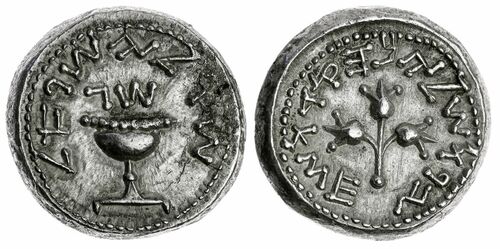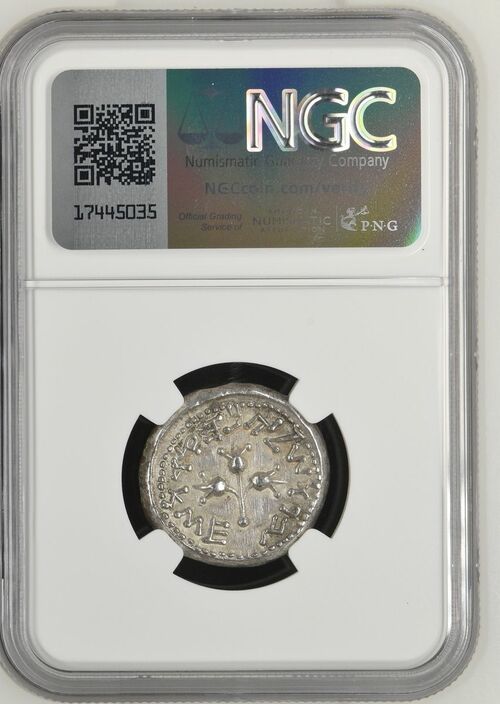Auction: 24005 - The Official Coinex Auction of Ancient, British and World Coins
Lot: 38
NGC AU | Roman Judaea, The Jewish War (AD 66-70), AR Shekel, dated Year 3 = AD 69/70, 'Shekel of Israel' (Paleo-Hebrew) surrounding cup with pearled rim, 'Year 3' above, rev. 'Jerusalem the Holy' (Paleo-Hebrew) surrounding sprig of three pomegranates, 14.15g (Kadman 20; Meshorer 202; AJC II 18; Hendin 1361), obverse extremely fine and perfectly-centred, reverse slightly worn to upper edge but otherwise, toned, lustrous, and extremely fine, a lovely example of this iconic issue, in an NGC 'Ancients' holder, graded About Uncirculated ~ Brushed (Strike: 5/5, Surface: 3/5) [NGC Cert. #5878654-001]
Provenance
Purchased from L. Alexander Wolf Ancient Art and Artefacts, Jerusalem, 2005
"Upon my arrival in Acre, I was shown silver coins belonging to the local elders, with designs stamped on them; on the one side, a type of stick with almond-buds, and on the other, a bowl. They maintained these symbols to be the almond-blossom staff of Aaron the High Priest, and the other side, a dish of the Manna which the Children of Israel were fed in the desert."
So Nachmanides records his first encounter with Jewish revolt coins in his 12th century commentary on the Torah. The interpretation is not too far off- now we would say that they are pomegranates instead of almonds. The chalice for holding the Manna too could just be a bowl for holding the Omer in the temple. Nevertheless, both the obverse and reverse types are heavily connected to Jewish ritual in the temple itself. The coin fundamentally rejects Greek and Roman numismatic precedents in an effort to establish an inherently Jewish coinage.
Such a coinage was uniquely suitable to their desperate break for freedom that began in AD 66. Roman abuses, especially those committed by the overzealous procurator Gessius Florus, had provoked the province to revolt in 66 BC. One of Florus' most notorious acts had been to steal most of the silver from the temple in Jerusalem. It is likely that these silver revolt coins were made from the little left over.
As far as revolts went against the Romans, this one was remarkably successful. Cestius Gallus, the governor of Syria, swooped in to crush the rebels, only to have his legion routed and its eagle captured. Nero then ordered Vespasian to resolve the rapidly deteriorating situation with four legions. Vespasian and his son Titus would ultimately be successful, however the suicide of Nero and the subsequent civil war, which saw Vespasian himself rise to the purple, delayed them. Vespasian left his son to take Jerusalem itself, a notoriously bloody siege which lasted seven months. Refugees fleeing the starving city were crucified around the walls - at height of the siege the Romans carried out 500 crucifixions a day. The inevitable carnage at the fall of the city saw the immolation of the temple itself and would provoke the great diaspora for the Jewish people.
The last pockets of rebels were cleared out of various forts up to AD 74. The last stand was made at the hilltop fort at Masada where, according to Josephus, rather than be conquered by the Romans the remaining 960 committed mass suicide.
The victory for the Romans was total. The chalice represented on the Shekel likely too is represented on the triumphal arch of Titus among the many spoils of war shipped to Rome.
Subject to 20% VAT on Buyer’s Premium. For more information please view Terms and Conditions for Buyers.
Sold for
£6,200
Starting price
£5000













